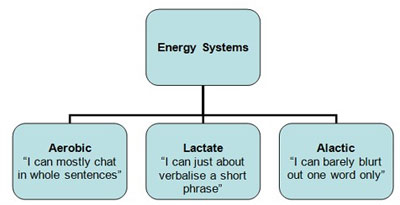

Running Talk Test
The running talk test can be applied to monitor running exercise intensity, Dr Matt Long explores.
Nature has blessed us with five senses, one of which—the ability to talk—is an excellent way of self-regulating the intensity of your training activity as an athlete. Traditionally, the talk test has remained almost the exclusive preserve of the endurance athlete, but it is useful for both the middle-distance athlete and the sprinter.
As athletes, we may use one, two, or all three energy systems: Alactic, Lactate, and Aerobic. The alactic system predominates in the shortest sprints, the lactate system for longer sprints and middle-distance running, and the aerobic system for endurance athletes.
The talk test and endurance running
Research conducted in 2011 at the Robert Kertzer Exercise Physiology Laboratory, University of New Hampshire[3], confirmed that the subjective measure of the talk test might give the endurance runner an indication of when their lactate threshold is being approached, meaning if this intensity is maintained, the duration of the activity is limited. When athletes rapidly increase blood lactate levels, the Onset of Blood Lactate Accumulation (OBLA) occurs. The balance between lactate addition to and removal from the blood is disturbed at this critical point. When predominantly utilising the aerobic energy system during an endurance run, the maximal lactate steady state (MaxLass or MLSS) is a level of exertion which, if exceeded, will result in a switch to the predominant utilisation of the lactate energy system, which cannot be sustained effectively for more than two to three minutes.
As well as delaying using the lactate system, there are training sessions when the endurance athlete wishes to almost exclusively use the aerobic energy system, such as the proverbial long, steady Sunday morning run or the shorter recovery run the day after a competition. According to Hanc (2004)[2], the talk test is a reliable intensity gauge for keeping within the optimal aerobic zone, which is thought to be between 65-80% of the maximum heart rate.
Your aerobic energy system is predominating if you can chat with someone in whole sentences. Your body is working at an intensity where there is sufficient oxygen to produce the required energy while also being used to talk. However, as the intensity increases, the oxygen demand of the muscles increases, meaning that there is less and less oxygen available to be used in the process of talking.
Conclusions
Try the following to see whether you are working the relevant energy system(s) for your event(s):

Article Reference
The information on this page is adapted from Long (2012)[1] with the author's kind permission and Athletics Weekly.
References
- LONG, M (2012) It's good to talk. Athletics Weekly, November 15th 2012, p. 39
- HANC, J. (2004) Symmetries and conservation laws: Consequences of Noether's theorem. Am. J. Phys. 72, p. 428
- QUINNA, J. and COONSA, B.A. (2011) The Talk Test and its relationship with the ventilatory and lactate thresholds. Journal of Sports Sciences, Volume 29, Issue 11, p. 1175-1182
Page Reference
If you quote information from this page in your work, then the reference for this page is:
- LONG, M. (2014) Running Talk Test [WWW] Available from: https://www.brianmac.co.uk/articles/article160.htm [Accessed
About the Author
Dr Matt Long is a British Athletics Coach and Education Tutor who has lectured and coached at the British Milers Club Academy. Jamie French's assistance is acknowledged.